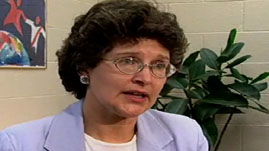Teachers' Domain - Digital Media for the Classroom and Professional Development
User: Preview




Teacher Susan Christy (Highlands Middle School, Ft. Thomas, Ky.) has her seventh-grade social studies students look for the answers to one or two questions before reading a paragraph in their textbooks. She explains the importance of reading for answers.
Reading Guide (Document)
Teacher Susan Christy (Highlands Middle, Ft. Thomas, Ky.) is teaching a lesson on the Neolithic Revolution, using scaffolding and differentiation to address the needs of students with literacy challenges.
To engage the class as they read the text sections together, Susan asks students to look for the answers to one or two questions before reading each paragraph. Using a computer program with infrared technology, Susan projects the questions with multiple-choice answers on a screen in the front of the room. Each student answers the question using a keypad much like a television remote. The program instantly shows a graph of how the students answered as a class. Another way students read for answers is in a learning log dedicated to writing to learn activities.
Susan describes the next step in the lesson, guided reading. Working independently, students read a summary of the text they read in class with key words missing. Students review the text read in class and plug in the correct answer in the paraphrased version.
This video was originally part of a multimedia professional development resource, Literacy Without Limits, produced by KET in 2007 in collaboration with the Kentucky Department of Education.
What characteristics of highly effective teaching and learning do you observe?
Kentucky Department of Education: Characteristics of Highly Effective Teaching and Learning
 Loading Standards
Loading Standards